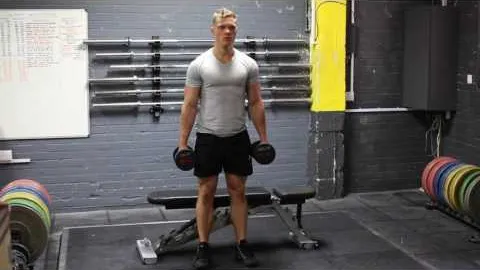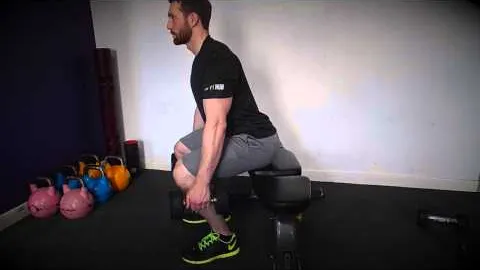


The Dumbbell Squat to Bench exercise is a highly effective compound movement that targets multiple muscle groups in your lower body. This exercise combines the benefits of squats and bench press, providing not only strength gains but also improving stability and balance. Whether you are a beginner or an experienced lifter, incorporating this exercise into your routine is a great way to enhance your overall fitness and achieve your health goals.
The Dumbbell Squat to Bench exercise engages various muscle groups in your body, including your quadriceps, hamstrings, glutes, core, and upper body muscles. It activates both the lower and the upper body simultaneously, making it a highly efficient exercise for those who want to optimize their workout time.
By performing the Dumbbell Squat to Bench exercise, you are exerting force through your legs and glutes to lift the weight up. This movement mimics daily activities such as lifting heavy objects or climbing stairs, making it a highly functional exercise that translates to real-life strength gains.
Maintaining your balance is crucial while performing the Dumbbell Squat to Bench exercise. The movement challenges your core muscles to stabilize your body throughout the exercise, leading to improved overall balance and stability. This can be particularly beneficial for athletes involved in sports that require agility and coordination.
The Dumbbell Squat to Bench exercise stimulates muscle growth in your lower body, helping to increase muscle definition and tone. The repeated contractions of the target muscles result in improved muscle size, shape, and overall aesthetics.
Maintaining proper form during the Dumbbell Squat to Bench exercise is crucial to maximize its benefits while minimizing the risk of injury. Here are some tips to help you perform this exercise safely and effectively:
Start with Light Weights: If you are new to this exercise or strength training in general, it is recommended to start with light weights until you become comfortable with the movement. Gradually increase the weight as your strength and technique improve.
Maintain a Neutral Spine: Keep your back straight and avoid rounding or arching your back throughout the exercise. This will help protect your spine and prevent unnecessary strain.
Engage Your Core: To maintain balance and stability, engage your core muscles by pulling your belly button in towards your spine. This will help support your entire body during the movement.
Controlled Descent and Ascent: Ensure you lower your body in a controlled manner, avoiding abrupt or jerky movements. This will help recruit more muscle fibers and enhance the effectiveness of the exercise.
Choose the Right Bench Height: The height of the bench plays a crucial role in this exercise. It should be positioned at a height that allows your thighs to be parallel to the ground when you reach the squatting position. This will ensure proper depth and alignment throughout the movement.
To fully benefit from the Dumbbell Squat to Bench exercise, it's important to incorporate it into a well-rounded workout routine. Here are some suggestions on how to include this exercise in your weekly training program:
Warm-Up: Prior to performing the Dumbbell Squat to Bench exercise, warm up your lower body by performing dynamic stretches such as leg swings, hip circles, or walking lunges. This will help prepare your muscles for the upcoming workout.
Compound Movement: As a compound exercise, the Dumbbell Squat to Bench exercise can be performed as part of your leg day routine or full-body workout. Pair it with other compound movements such as deadlifts, lunges, or bench press to fully engage multiple muscle groups.
Sets and Repetitions: Aim for 3-4 sets of 8-12 repetitions per set. Adjust the weight accordingly to ensure you are challenging your muscles while maintaining proper form throughout the exercise.
Progressive Overload: To continually challenge your muscles and encourage growth, gradually increase the weight lifted over time. This progressive overload stimulates muscle adaptation and promotes strength gains.
Rest and Recovery: Allow adequate rest between sets and workouts to facilitate muscle recovery. Aim for 48-72 hours of rest before targeting the same muscle group again.
The Dumbbell Squat to Bench exercise offers a multitude of benefits, including improved strength, stability, balance, and muscle definition. By incorporating this exercise into your training routine, you can enhance your overall fitness level and work towards achieving your health and wellness goals. Remember to prioritize proper form and safety, and gradually increase the intensity to continue challenging your muscles. Together with a balanced diet and lifestyle, the Dumbbell Squat to Bench exercise can be a valuable addition to your fitness journey.
If you're looking for a gym, fitness club or yoga studio, you've come to the right place.
You can find information about gyms in your area. Browse catalog of gyms and find gyms with classes which are you looking for.
On gym page you can find simple information like address, phone or website. You can find list of available classes. You can check availability of personal training or small group classes. On place page you can also see information about open hours.
You can find gyms near you with amenities, courts, studios and equipments.
Use our map to find gym at your city or district.
In Gym Navigator you can find list of exercises with movies for many body parts.
You can browse exercises catalog and find exercises the best of you.
You can also find exercises grouped into workout plans, which you can use to improve you body. Each routine show you exercises one by one and give you possibility to count you progress and count down rest time.